Childhood and what it leaves in the soul has always been an object of study and interest for philosophers, poets and artists. Memories and emotions recur throughout life and knock on the door of the unconscious, which reworks their essence, their contents, living with them. The artistic work by Julia Haumont (1991), on display until 13 January 2024 at the CAR gallery in Bologna, through the exhibition itinerary entitled Oublier, rêver (Forget, dream in English), evokes, concretizes, reworks and addresses the inner and profound sphere linked to this life period, creating sculptural works representing little girls, with features evoking those of the artist herself.
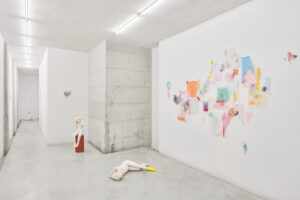
Julia Haumont, “Oublier, rêver”, installation view at CAR gallery, photo credit: Manuel Montesano, courtesy CAR gallery
Elora Weill Engerer, in the critical text accompanying the exhibition, entitled Faire l’enfant, asks: «What do Julia Haumont’s young girls dream? Under a casual air and languid postures, these figures deploy a poetic gestural repertoire that enlivens their still infantile bodies. Often half-closed, the gaze is drawn towards an internal universe, as if half asleep, reinforcing the silence in which these children are immersed (infans in Latin etymologically means “who does not speak”). They play following their imagination…”. The author of the critical text draws attention to the word “infante” which derives from infans, meaning one who is incapable of speaking. In turn, the term has in its root the verb fari, already present in the ancient Greek φημί (fēmì), which means to speak, strengthened in turn by the presence of the prefix in, which it brings a negative meaning of impossibility.
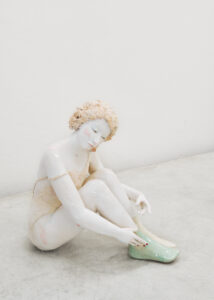
Julia Haumont, “Sans titre n. 25”, 2022, photo credit: Manuel Montesano, courtesy CAR gallery
Although the sculptural works by the Parisian artist are linked to childhood, they deviate from the etymological root, resulting in speech, as they express fragility and strength, innocence and sensuality, balance between the expressiveness of the faces and the white surface of the glazed ceramic, the material chosen to make them. By carefully observing the sculptures, the viewer can notice the presence of some stains, signs that interrupt the serene, placid, calm and balanced rhythm of the lines and contours.
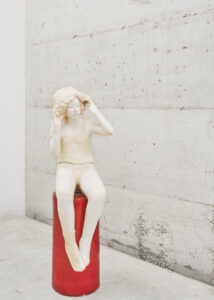
Julia Haumont, “Sans titre n. 15”, 2020, photo credit: Manuel Montesano, courtesy CAR gallery
As part of the exhibition itinerary there are installations made with textile materials. As it is indicated by the artist on the exhibition dossier: «Completing my studies in Fine Arts, I began, obsessively, to paint photographs from my family archives, and then reproduce them as engravings. Having previously studied fashion design, textiles gradually returned to my artistic practice and engravings were printed onto gauze. […] On the prints I add randomness: stains, tears, which contribute to creating a certain ambiguity oscillating between violence and sweetness. The textile compositions I create are an extension of this research: I try to recreate the same affects by purifying my language and using only matter, lines and colors. In my abstract textile compositions, they are dyed, assembled, torn, sewn together, always using the archetypes of childhood: colours, sequins, beads and embroidery. The fragility of the support also recalls the fragility of this era. It is also a pictorial research, a game: as if I were projecting myself into a childish configuration, I have fun with the colors and elements to compose harmonious lines on the wall which, without any limits of format, take the place of the paper. Matisse’s paper cuttings were very important to me and opened a new path in my work».
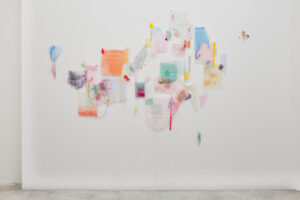
Julia Haumont, “Composition n. 6”, 2023, photo credit: Manuel Montesano, courtesy CAR gallery
From Julia Haumont’s words we can deduce the complex interior and artistic research from which the tangible expressions of her thought arose, which materialized through her work. The Parisian artist lays herself bare, in a very particular way, making the viewer participate in her delicacy, but at the same time in her strength and ability to tell in a completely contemporary way, albeit with traditional and consolidated materials in the art such as ceramics and fabrics, her internal reflections on childhood and life. With the elaboration of thought, Julia Haumont consciously expresses, despite her young age, her own intellectual and interior movement through material representations, and, allowing herself to be led into the unknown paths of the soul, brings out its essence, expressing, through artistic technique, its idea, intuition, memories.
Info:
Julia Haumont. Oublier, rêver
11.11.2023 – 13.01.2024
CAR DRDE Gallery
Manifattura delle Arti- Via Azzo Gardino 14/A, Bologna
www.cardrde.com
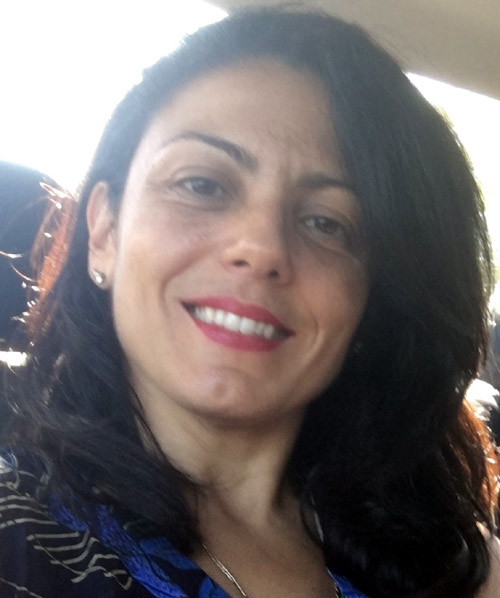
She has a scientific background, but also a great passion for art, which she loves to tell, admiring all its expressions.






NO COMMENT